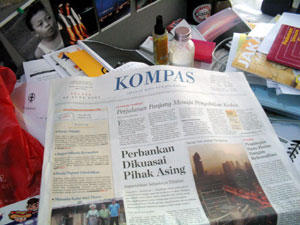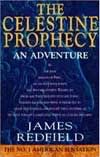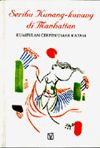gone in twenty years

My boss, the dutch guy, who happens to be on a holiday in a far away land dropped this article of Sachs' (see below) into my inbox.
Click here to know more about Jeffrey Sachs. He is visually on the left of this text. Yeah, that's his photo.
Wikipedia wrote that, according to Sachs, with the right policies, mass destitution - like the 1.1 billion extremely poor living on less than $1 a day - can be eliminated within 20 years.(1)
I'm kinda skeptical about Sachs' statement. Mostly because I have no clue how it can possibly done. Technically speaking, it all depends on each country's policy and political willingness to make it happen. But again, politics has many sides, faces and interests (this latter one is the magic word *grins*). I don't think any government would ever willingly make a pro-poor policy simply because there are so many intertwining interests in it. Any examples? Well, I can't really explain it here. Why? Well, I have limited English ability (Yes, I am not a native, never been abroad in any English-speaking country myself. Don't you realize that by now? *d'oh*).
I believe Sachs' wishes can only be done if.. there you go again, if Sachs can talk to the UN, would the US back it up? If US government (note: government means the president et. al.) back it up, would the industry back it up?
Anyways, have fun reading this article. I'd better shut up until I get my hands on "The End of Poverty", Sachs' most recent book.
BTW, there are more on Sachs' articles in Project-Syndicate.
===========FORWARDED TEXT==========
New York Times - June 25, 2005
Four Easy Pieces
By JEFFREY D. SACHS
At a time when Africa could achieve so much success in escaping poverty, America's strategy for helping the continent is in a shambles.
The head of President Bush's Millennium Challenge Corporation recently resigned after failing to get the program moving. Democratically elected African leaders have criticized the lack of action by the United States. Recent Congressional hearings showed that America's efforts to control malaria in Africa have been more about advertising than controlling malaria. And, the president recently rebuffed a call by Prime Minister Tony Blair of Britain to announce a worldwide effort to double aid to Africa before the Group of 8 summit meeting next month.
Contrary to a world lining up to back Mr. Blair, and to repeated studies showing that Africa could effectively use a doubling of aid by 2010, Mr. Bush instead announced a small additional amount of emergency food aid. This highlighted the gap between America's mistaken approach of shipping food relief versus helping Africans to grow more food.
And while the Group of 8 nations have agreed to a new debt cancellation deal for Africa, it is only a small step, worth around $1.5 billion a year of the additional $25 billion a year that Africa needs. The Bush administration said the United States would offset its share of the cost (around $150 million a year) by cutting other aid.
The mess is especially shocking because it amounts to a death sentence for more than 6 million Africans a year who die of preventable and treatable causes, including undernourishment, a lack of safe drinking water, malaria, tuberculosis and AIDS. The only bright spot in America's policy on Africa is the president's emergency program to fight AIDS, which is distributing antiretroviral medicine to more than 200,000 Africans, with a target of two million by 2008.
The lessons are clear from that success story and others like it. Foreign aid should be targeted to specific, measurable, achievable and bold goals. Proven technologies such as antiretroviral medicines should be featured. Timetables should be prepared. The United States should help countries that are prepared to help themselves. Americans should be encouraged to understand the roots of the African crisis and its solution. Bipartisan support should be sought.
Here then is how President Bush and Congress could quickly fix the broken strategy on Africa.
First, agree with Tony Blair, and most of the world, to double overall aid to Africa, focusing on four interconnected priorities: growing more food, fighting disease, ensuring that children are in school and building critical infrastructure (including roads, energy services, water and sanitation). In the worldwide package, the contribution from the United States would rise from $3 billion this year to around $15 billion by 2010.
Second, set quantitative targets based on the Millennium Development Goals as agreed to by the United States and all other countries. These goals keep everybody accountable. They can be used to monitor progress and make midcourse corrections.
Third, get the Millennium Challenge Corporation running on a serious level. The program was supposed to have disbursed $10 billion from 2003 to 2005, including $5 billion this year - but it has disbursed almost nothing. It should focus on practical investments in the four priority areas, disbursing at least $8 billion a year by 2010, directed mainly to Africa.
Fourth, explain the truth to the American people about the small level of United States aid to Africa. Of the $3 billion or so in American assistance this year, most pays for emergency food aid and for American salaries. Aid for actual investments, such as fighting malaria and promoting safe drinking water, isn't very much. It translates to perhaps $1 of aid for each African and a $2 contribution per American.
Increased investments could make all the difference. With a private philanthropic contribution to a group of villages in Western Kenya, the Earth Institute at Columbia University has helped farmers use improved seed varieties and replenish their soil nutrients, leading to an approximate tripling of food output in just one growing season. With a scaled response, Africans could enjoy a 21st-century Green Revolution, tripling the continent's food yields and escaping the chronic cycles of hunger, poverty and disease.
Similarly, Africans could fight and control malaria, which claims around 200,000 lives a month. About $3 billion a year would support a mass distribution of medicines and long-lasting insecticide-treated bed nets. The United States could contribute $1 billion, amounting to a little more than $3 from each American a year. Former President Jimmy Carter could lead the task, given his record of success in helping Africa control other diseases.
Aid could also help ensure that every poor child in Africa attends school. Increased financing could help end school fees, pay for more classrooms and teachers, buy school meals that contain locally produced foods and invest in water and power so women and children do not continue to spend their lives fetching water and wood for fuel.
Inaction by the United States will claim millions of lives and add to global instability. By joining the new worldwide effort to support Africa, Mr. Bush would honor America's longstanding but unmet commitments, our security interests and our nation's generosity.
Jeffrey D. Sachs is the director of the Earth Institute at Columbia University and the author of "The End of Poverty."
===========END OF FILE==========
---------------------------
Image courtesy of:
http://en.wikipedia.org/wiki/Image:Jeffrey-sachs.jpg
Jeffrey Sachs' article is a courtesy of:
The New York Times, June 25, 2005



















